The Musicarta Canon Project Module Three
Triads in the Treble
In Module Three of the Musicarta Canon Project you add a third note to the right hand thirds to make triads (three-note chords) in the treble. Here is the module performance, showing what can be done with the triads you will learn.
Forming the triads
Revise the string of thirds in the treble from Modules One and Two.

Play them with two hands.
Now play them with just the right hand.
Now listen to this string of treble notes. It is slightly different.

The sound is ‘filled out’ - a third note has
been added below the thirds to make a 'triad' (three-note chord).
The third note in the treble chords is what we add to the Canon performance in this module.
Playing the triads with two hands
The easiest way to play the triads is to play the new note with the left hand and the Module One thirds with the right.
Revise the thirds, playing with the right hand only. Use any fingering for now.

Here is the new ‘voice’ (line of notes). Practice with the left hand, using the fingering shown.

You need to know this line of notes by heart!
Play the hands together. This music shows the notes on two treble clef staves, right hand on the top, left hand underneath. This makes it obvious which hand plays what. The hands are still right next to each other on the keyboard.

Triad patterns using two hands
You can start playing variations right away by ‘waggling’ the triads as you did the thirds in Module One.
Your part is shown on the (upper) treble clef stave of the following music, with the RH notes stems up, LH notes stems down.
Listen to the audio performance files (with chord accompaniment) and study the music of the following examples. Watch the MIDI performance on MidiPiano for more clarity. Play along with a backing track recordings, or with a friend playing the accompaniment.
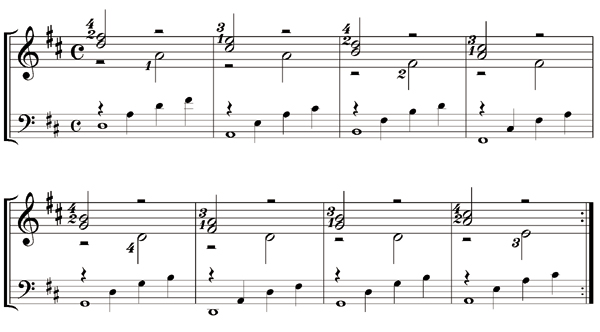
For another variation, you can simply alternate left and right hands twice as quickly.
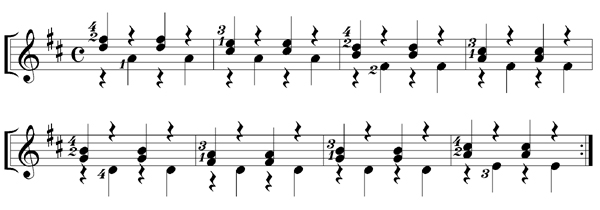
Now mix and match the note lengths.
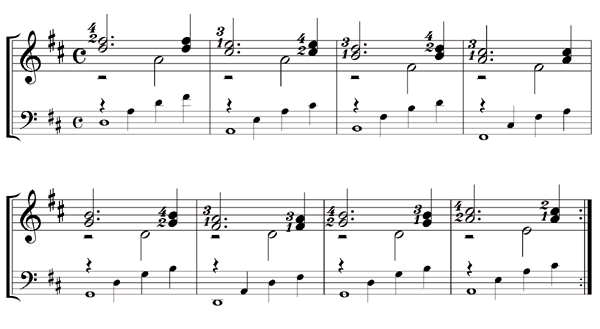
Splitting the triad notes differently
The variations so far have split the three notes of the triad into two notes with the right hand and one with the left.
You can divide them the other way as well, with the left hand playing two of the notes and the right hand just one.

This makes it much easier to play extra notes in the top voice (line of notes).
(The blue notes are an accompaniment pattern that you will learn later.)
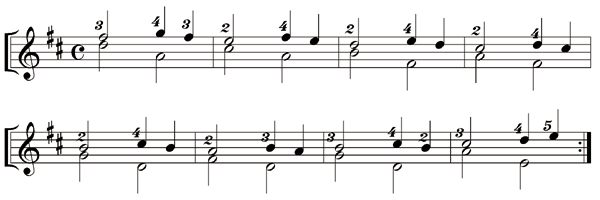
Double the left hand changing speed and use a ‘next door note’ pattern from the previous modules in the right hand.
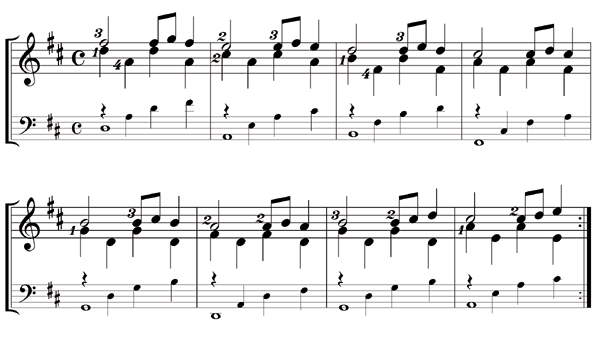
A practice pattern
In the following example, you play a top-voice pattern from Module Two over the double-speed 'waggling' left hand notes.
Watch the practice-tempo virtual piano performance. Fill the full eight bars mechanically with the same pattern. There are ‘tweaks’ in bars seven and eight which you can ignore for now if you wish.
In the music below, the left hand notes are shown as whole notes. In the last four bars, only the basic triads are shown. This is how the creative musician thinks - in terms of the basics behind the patterns.
Build up to performance tempo and play over
your backing track or recording. The blue notes show an accompaniment a friend could play.
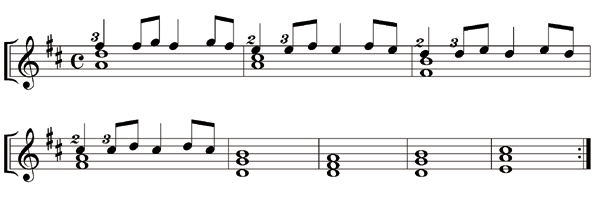
Musicarta is
committed to helping you cultivate a habit of ‘messing around with chords’, so
that whenever you see a triad, your fingers will automatically start bringing
it to life with a rhythmic waggle (for example), or an exploration of what the next-door notes can add to the performance – the basis of successful pop keyboard improvisation.
Audio challenge
Now listen to this audio performance clip.
It’s a two-bar pattern, nearly the same as the previous one, but some notes are missed out in both hands.
Listen carefully and try to play the pattern. You can probably use your media player controls to listen to the clip over and over and slow it down.
The virtual piano performance is in the 'Answers' section at the bottom of the page, but give yourself a good go at "getting it by ear".
That random chorus
One chorus of the module performance takes flight into new territory altogether. It's this one.
The module performance
The module performance ‘mixes and matches’
the various keyboard textures you have learned in this module. Listen to it
again and see if you can play it by ear first.
Here's the virtual piano performance again.
Answers
Here is the virtual piano performance of the audio challenge chorus.
- The left hand misses some of the previous pattern notes out in the odd-numbered bars;
- The right hand misses some of the notes out in the even-numbered bars.
Play the treble part with two hands over a backing track or commercial recording.
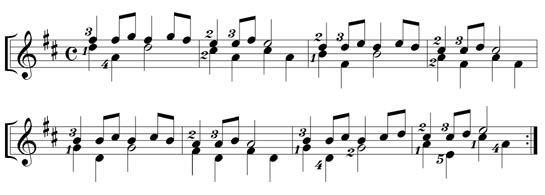
|
OUT NOW! |
THE MUSICARTA BEAT & RHYTHM WORKBOOK At last! An effective approach to keyboard rhythm & syncopation skills. Learn more! |
ONLY $24.95! |
THE MUSICARTA
|
The MusicartaA methodical approach to keyboard syncopation for
|
PUBLICATIONS
exciting keyboard
creativity courses
CHORDS 101
WORKBOOK

~HANON~
video course

Musicarta
Patreon
PENTATONICS
WORKBOOK
video course

Creative Keyboard
video course

BEAT AND RHYTHM
WORKBOOK

- Volume 1 -

12-BAR PIANO
STYLES WORKBOOK

MUSICARTA MODES
WORKBOOK

PIANO STYLE

CANON PROJECT
video course

VARIATIONS
video course


- Piano Solo -
video course

- Piano Solo -


YouTube playlists





 THE LOGO
THE LOGO
